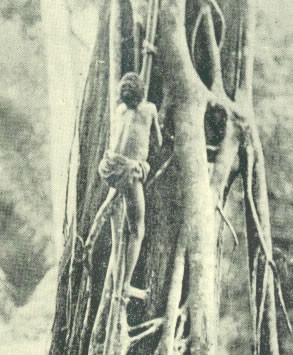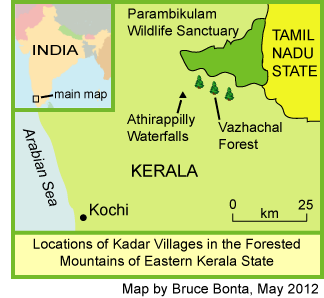Location. A society numbering just over 2,000 people, according to the 2001 census of India, who live in small villages in the Western Ghats mountain range of Kerala, in Southwestern India. Their communities are located in the Parambikulam Tiger Reserve, in the Vazhachal Forest Division to the south of it, and in the vicinity of the Athirappilly Waterfalls on the Chalakudy River, all between 50 and 75 km NE of the major Kerala port city of Kochi. A small number also live in the Anamalai Hills just to the east in Tamil Nadu.

Economy. The Kadar, formerly a nomadic people, are now mostly settled into villages. They subsist on gathering food and other products from the forest, fishing, keeping some animals, and working for cash income as assistants in wildlife research projects, forest management workers, and staffers at nature reserves. A recent journal article indicates that over 50 percent of the Kadar economy still consists of traditional gathering of forest plants, though they also take a strong interest in managing their forests.
Beliefs that Foster Peacefulness. The Kadar have two funeral ceremonies, one when the deceased is buried, and a second one a bit later at which a large crowd of people assembles for a feast. After the second celebration, the soul of the dead person stops loitering about in the jungle and goes into the sky to join other souls. Acts of kindness appear to assist the souls in going up to a heaven-like existence, and anti-social behavior in life may lead to a hell-like afterlife. U.R. Ehrenfels, however, believes that these conceptions of reward and punishment have been introduced relatively recently from the surrounding Tamil peoples.
Avoiding and Resolving Conflicts. An effective way for the Kadar to resolve conflicts is for people to separate. For example, in one village one evening, a very loud and vociferous fight disturbed everyone. A woman was loudly abusing her husband because he had bought what she thought were nice presents for two of his children by a previous marriage, but a worthless one for their own daughter. For over an hour she loudly accused him of having affairs with other women, but he quietly denied these accusations to the listening villagers. Finally he suggested that it was time for everyone to go to sleep. In the morning she was gone, leaving word that she was going to divorce him, though she returned and settled in with him again a week later.
Gender Relations. Kadar society has traditionally accorded equality to the sexes but these beliefs are fast being weakened due to the influence of the surrounding Indian society. Wage labor opportunities are available primarily for men, and when a man is able to afford a sari for his wife, she wears it in order to avoid the stigma of being naked above the waist. Since the clothing may prevent her from foraging in the forest, she becomes increasingly dependent on her husband and his job, losing her independence. Furthermore, the social stigma against bare-chested women has produced an attitude of servility by the women toward outsiders; they feel they have to hurriedly cover their breasts whenever they pass outsiders.

Raising Children. The Kadar are normally quite indulgent and permissive toward their children; they will interfere benevolently when necessary, distracting children into other activities when they start to cry or fight. One day a small child was crying furiously for no apparent reason, with two or three women unable to comfort it. Suddenly, a young woman began screaming also, picked the child up, and ran off to a nearby grove of plantain. The sudden activity and excitement distracted the child enough to forget the bad mood. Children play without competition, hiding, catching, or running away–their games are based on the simple enjoyment of the activity of the moment. Adults rarely use corporal punishment on children.
Social Practices. Beyond the nuclear family, the Kadar maintain strong, affectionate ties with parents, nephews, nieces, uncles and aunts of both spouses. Their villages are impermanent, with residents composed of people who feel like living there at the moment. People will come and go within family relationships as well as within the village as much as they wish depending on circumstances of personal relationships and economic opportunities. Women are as free to move out of marriage as men are. The villages have no indigenous chiefs or headmen, except the ones installed by the authorities in the surrounding states. Even these carry no authority among the Kadar to punish or coerce.
Cooperation and Competition. Kadar children generally engage in cooperative group play and games of make believe. They do not appear to have games of competition, of running away, or of hiding and catching each other.
Social Control. Councils of elders hear evidence and pronounce their judgments on spouses who want to divorce due to various causes such as adultery or incompatibility. The councils can require offenders to submit to punishments, such as one man who was required to carry forty loads of sand to the home of another as punishment for offending him. Anyone who disobeys the judgment of the council might be ostracized—forced to leave the community and live alone in the forest. 
But How Much Violence Do They Really Experience? The Kadar almost never have physical fights about issues. A wife might berate her husband for not having enough western material comforts, or someone might accuse another of taking money to purchase drugs, but fighting does not result. There was no memory among them of murder or violent acts of revenge, and they had no bows and arrows or memory of ever having had them—at least as of 1952. Local forestry and police officials confirmed the total absence of crime at that time. During the 20th century, with increased contact with the lowland civilizations that surround them, they have learned the art of cheating. However, whatever they might gain is quickly bartered away for other products, which will be shared with other Kadar.
More Resources in this Website:
- Alcoholism has become a serious problem with some Kadar men, as reported in May 2011.
- The Kadar boycotted an election to protest being ignored by the government.
- Some Kadar have become involved with scientific research on hornbills and others help protect tigers in a major reserve.
Sources in Print: Ehrenfels 1952; Gupta and Chandra 1996; Thurston 1909
Sources on the Web: Mahendrakumar, M.S. 2005.
Updates—News and Reviews:
Selected Recent Stories
September 3, 2015. The Kadar Are in the News
August 20, 2015. Paliyan and Kadar Dances
July 23, 2015. Kerala and its Peaceful Societies Part 1, the Kadar
June 4, 2015. A Dam Could Destroy Indigenous Communities [journal article review]
All Stories
All stories in this website about the Kadar are listed in the News and Reviews Subject Listing
